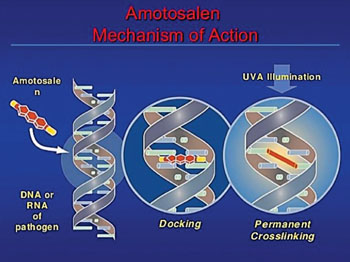Zika Virus Inactivated in Plasma for Transfusion
By LabMedica International staff writers
Posted on 03 Apr 2016
The potential for Zika virus (ZIKV) transmission through blood transfusion has been demonstrated during the French Polynesian outbreak as 2.8% of blood donors, who were asymptomatic at the time of donation, were found positive for acute ZIKV infection using specific reverse transcription–polymerase chain reaction (RT-PCR). Posted on 03 Apr 2016
Several processes have been developed for the inactivation of pathogens during the preparation of fresh-frozen plasma (FFP) and platelet (PLT) concentrates. Among them, a photochemical treatment using the psoralen, amotosalen, S-59, in combination with ultraviolet A (UVA) illumination, has been shown to inactivate a broad range of viruses, bacteria, and protozoans.

Image: Schematics of the combination of Amotosalen and UVA illumination for eliminating pathogens from donor blood for transfusions (Magdy El Ekiaby, MD).
A team of scientists working with those at the Institut Louis Malardé (Papeete, Tahiti, French Polynesia) collected plasma units from USA blood donors to eliminate risk of ZIKV antibodies. To assess the absence of previous infections by Flaviviruses known to circulate in the USA, Dengue and West Nile (DENV and WNV), each plasma unit was tested with a dengue immunoglobulin (Ig)G capture kit (Platelia, Bio-Rad; Hercules, CA, USA) and a classic WNV IgG kit (Serion Elisa, Abcam; Cambridge, UK), to detect IgG antibodies against DENV and WNV, respectively. The 26 sera of French Polynesian ZIKV-infected and asymptomatic blood donors were obtained from the blood bank center of French Polynesia.
Four plasma units (A, B, C, and D) were inoculated with ZIKV. A sample from each infected plasma unit (pre-inactivation sample) was then collected and stored at -80 °C until the determination of viral titers and RNA loads. Inoculated Plasma Units A, B, and C were treated with amotosalen combined with UVA illumination, whereas inoculated Plasma Unit D was not inactivated and was the positive control. After transfer into a container with a compound absorption device that removes the residual amotosalen and the free photoproducts, samples from each inactivated plasma unit (inactivated samples) and from the positive control (non-inactivated sample) were collected and stored at -80 °C until the determination of viral titers and RNA loads.
For the detection of replicative ZIKV, all pre-, post-, and non-inactivated samples were inoculated in triplicate on VERO cells in 24-well plates, and five successive passages were performed. After each passage, indirect immunofluorescence assay was performed to detect ZIKV inoculated cells, using anti-flavivirus mouse antibodies 4G2. For all plasma (pre-, post-, and non-inactivated samples), cell supernatant, and serum samples, RNA extraction was performed using an extraction system and real-time RT-PCR was performed in a Bio-Rad CFX96 thermocycler.
The mean ZIKV titers and RNA loads in plasma before inactivation were respectively 6.57 log 50% tissue culture infectious dose (TCID50)/mL and 10.25 log copies/mL. After inactivation, the mean ZIKV RNA loads was 9.51 log copies/mL, but cell cultures inoculated with inactivated plasma did not result in infected cells and did not produce any replicative virus after one passage, nor detectable viral RNA from the second passage. The authors concluded that amotosalen combined with UVA light inactivates ZIKV in fresh-frozen plasma. This inactivation process is of particular interest to prevent plasma transfusion-transmitted ZIKV infections in areas such as French Polynesia, where several arboviruses are co-circulating. The study was published in the January 2016 issue of the journal Transfusion.
Related Links:
Institut Louis Malardé
Bio-Rad
Abcam














